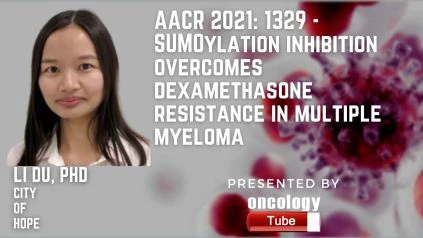Li Du, Ph.D. City of Hope speaks about AACR 2021 Abstract – 1329 – SUMOylation Inhibition Overcomes Dexamethasone Resistance In Multiple Myeloma.
Link to Abstract:
https://www.abstractsonline.com/pp8/#!/9325/presentation/2180
Synopsis:
Multiple myeloma (MM), the second most prevalent hematopoietic cancer, is also incurable when patients relapse after reacting to treatment. Dexamethasone (Dex) is a corticosteroid that has been commonly used to treat multiple sclerosis (MM) as a single agent or in conjunction with other medications. In MM, however, both inherent and acquired Dex tolerance is linked to a weak prognosis. As a result, there is a constant need for the discovery of Dex resistance mechanisms and the development of new medicines to tackle resistance. SUMOylation, a post-translational modification characterized by the covalent binding of small ubiquitin-like modifier (SUMO) proteins to a lysine (Lys) residue on target proteins, is one possible mechanism by which Dex resistance may be controlled. The expression of the SUMO activating enzyme E1 (UBA2/SAE2) gene was substantially upregulated in MM and was linked to a poor prognosis. In the MM cell lines RPMI8226 and MM1S, knocking down SAE2 permanently or transiently decreased MM cell proliferation. TAK-981 is a novel, selective small-molecule inhibitor of the SUMO E1 enzyme in Phase 1 trials. TAK-981 increased Dex production in primary MM cells isolated from relapsing patients as opposed to single agents. The addition of TAK-981 to Dex therapy greatly increased the cytotoxicity of the Dex-resistant MM cell line MM1R. The anti-MM in vivo results of SUMOylation inhibition was investigated using a murine xenograft model in which MM1R cells were subcutaneously injected into NSG mice. In tandem with Dex, TAK-981 therapy significantly slowed tumor growth and decreased tumor load. In primary MM samples, analysis of UBA2 mRNA levels and cell viability assays with Dex treatment revealed that elevated SAE2 expression was associated with decreased sensitivity to Dex. Both of these findings suggested that SUMOylation was linked to Dex tolerance, and that inhibiting SUMOylation improved Dex sensitivity in MM. The expression of the glucocorticoid receptor (GR) has been established as a significant mechanism of Dex resistance in MM. TAK-981 therapy resulted in a dose-dependent rise in GR mRNA in primary MM samples. TAK-981 therapy decreased miR-130b, a microRNA that targets the GR 3’UTR, and was associated with an upregulation of GR mRNA in both primary samples and MM1S, MM1R cell lines. We performed genome-wide RNA and miRNA profiling in MM1S and MM1R cells with Dex, TAK-981 single or combination therapy to find novel miRNAs involved in Dex tolerance mechanisms. SUMOylation inhibition suppressed both miRs levels by regulating c-Myc protein stability, and we established miR-551b and miR-25 as novel miRs mediating Dex resistance. Finally, our findings show that inhibiting SUMOylation overcomes Dex resistance in MM by upregulating GR and downregulating miR-551b and miR-25. Our results point to SUMOylation as a novel mechanism of Dex tolerance, suggesting that a SUMO E1 inhibitor may be an effective treatment for MM.

